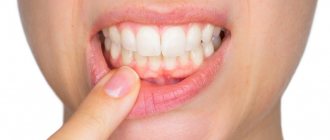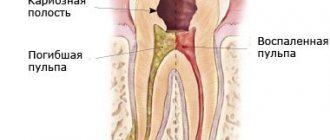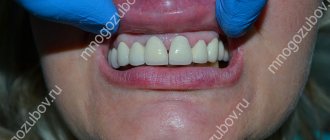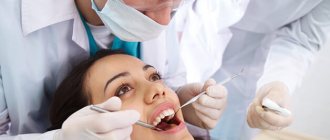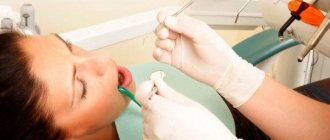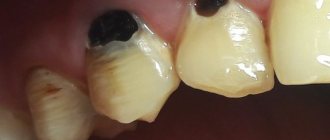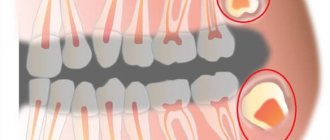There are several common reasons why a tooth hurts under a crown.
Causes of pain
As a rule, before installing a crown, the tooth is depulped - that is, the neurovascular bundle in the root and coronal part is removed, after which the canals are filled. Pain may be caused by some features of these manipulations:
- incomplete filling of the canals - as a result of the formation of voids in the root canals, an infectious process may begin to develop; Pus accumulates at the root tip, which causes pain. This is a common complication of endodontic treatment, especially in cases where the canals are too narrow or curved;
- subsidence of filling materials over time - even if the root canals are completely filled, changes in the physical properties of the materials can also lead to the appearance of voids - infection develops in them, inflammation spreads to the tissues near the apex of the tooth root;
- removal of the filling material beyond the root apex - “excess” material in the periodontal tissues can provoke irritation and inflammation.
Pulpitis. Inflammation of the pulp can occur in cases where a decision was made to preserve it - tooth processing can lead to a burn, the infectious process may already begin in the pulp and be asymptomatic, which becomes the cause of inflammation. Preserving living pulp before installing a crown on a tooth is a rare occurrence; as a rule, the “nerve” must be removed.
Perforation of the walls of the root canal. Perforation is the creation of a hole in the root canal, a phenomenon that occurs for several reasons:
- perforation may be a consequence of mechanical processing of the canal with a thin instrument - it must enter the canal along its entire length. If the canal is curved, then even a slight pressure can cause the instrument to pass through the tooth tissue;
- installation of a pin can lead to perforation - it is installed in the root canal, which, given the appropriate anatomical features of the structure of the root system, can also lead to the formation of a hole.
The hole is a “gateway” for infection—the tissue becomes inflamed some time after the pin is installed or endodontic treatment is performed, which causes pain.
Why does the tooth under the crown hurt?
The reason for this may be the presence of a foreign body in the canal. During endodontic treatment, the tip of the instrument may break off; subsequent filling of the canal with a foreign body leads to pain. There can be several reasons for breakage - the most common of them is the curvature of the canals. If they are difficult to pass, the tool may break due to the high load.
As a rule, in this case, the patient feels pain when exposed to temperatures, and the tooth under the crown also hurts when pressed. Pulsation may appear during exertion or chewing on the side with the crown installed. Tapping on a tooth also causes discomfort.
In order to avoid such a complication, the dentist must perform an x-ray diagnosis before installing a crown or any other dental prosthesis.
If the technology for processing and preparing the tooth for prosthetics is followed, installing a crown can also cause pain - if the design is too high for the bite, the patient feels discomfort when closing the jaws. This is why the stage of “trying on” the crown before its final installation is important - a good orthopedic dentist will first assess the degree of comfort for the patient.
Reasons why gums rise
Under the influence of provoking factors, periodontal disease, gingivitis and periodontitis develop.
At first, the gums, rising by a third, do not cause pain. Next, the base of the tooth is exposed, bleeding occurs during cleaning, and an unpleasant odor appears due to rotting food debris in the periodontal pocket.
The periodontium softens, becomes unable to hold the teeth, and they become loose. The patient experiences pain that makes drinking and eating difficult. The affected mucous membrane is vulnerable to microbes, becomes inflamed, and suppurates.
Periodontal disease
This is usually a consequence of metabolic disorders. All dental parts, when the gingival margin rises up or falls below the neck, can become exposed. The tissues are sensitive, painful, and bleeding.
In the absence of obvious inflammation, we are talking about periodontal disease as such.
But the exposure of teeth and an increase in their mobility subsequently leads to infection and inflammation of periodontal pockets.
Gingivitis
Inflammation of the gums without compromising the integrity of the periodontal transition can be of several types:
- Simple marginal (marginal), acute catarrhal or chronic gingivitis.
- Atrophic, with loss of tissue volume.
- Desquamative, with desquamation of the epithelium.
- Hypertrophic (hyperplastic), with an increase in the volume of the periodontal papillae, the gum hangs over the tooth, rises in the form of a lump or granuloma.
- Ulcerative, with tissue erosion.
Gum lesions are more common in adulthood. In preschoolers and schoolchildren, marginal changes occur.
Periodontitis
With periodontal inflammation, the destruction of the alveolar process of the jaw progresses, which is facilitated by the accumulation of bacteria in the expanded periodontal pocket.
In addition to the fact that the gum rises noticeably above the neck of the tooth, there is swelling, redness, and pain in this area. Gums bleed when brushing and eating solid foods.
If left untreated, purulent fistulas form, teeth become loose and fall out.
A pulpless tooth hurts
If the pulp has been removed, the pain is most often aching. It can radiate to the temple or ear. The main reason for this phenomenon is the exacerbation of chronic periodontitis. The choice of therapy method is determined by the presence or absence of a pin in the tooth root canal:
- there is no pin: the doctor opens the crown, unseals the root canals and treats them properly, after which he places materials impregnated with antibacterial agents into the tooth. Several changes to the medication may be required until complete relief is obtained and the inflammatory process is eliminated. After the symptoms have completely subsided, the canals are filled again and a new crown is installed;
- there is a pin: the doctor can cure periodontitis through surgery - resection of the apex of the tooth root. It is performed through a small incision in the gum, through which the source of infection is removed, and if necessary, the resulting void is filled with osteoplastic material. Typically, the intervention lasts from 30 to 60 minutes and is well tolerated by patients.
Treatment of pathology
Lateral flap
Using this method, it is possible to lift the gums. But it is rarely used due to the fact that healthy tissue has to be displaced onto damaged areas. This defect affects almost the entire jaw, so it is difficult to apply a lateral flap.
The positive quality of this method is the instant result. If all preventive standards are followed, the risk of relapse is minimized.
Surgery to correct gum recession
Collagen membrane
It is placed on the cortical plate of the alveolar process for tissue regeneration. When its functions are restored, it will be deleted. Although some dentists use absorbable materials that dissolve on their own after a certain period of time. But they just cost more. Due to the membrane, approximately 80% of tissues are restored.
Rinse preparations
You can purchase ready-made mouth rinses at the pharmacy. The most effective remain:
- Chlorophyllipt;
- Furacilin;
- Miramistin;
- Chlorhexidine;
- Forest balm;
- Malavit;
- Rotokan.
Before using any of the above medications, read the instructions, as some medications need to be diluted with water.
Gum pain
If the gums hurt, and not the tooth itself with a crown installed, there may be a deformation of the crown or a discrepancy in its size - the gums are mechanically damaged, which leads to inflammation and pain. For example, the edge of the crown extends under the gum or, on the contrary, does not reach its edge significantly - in the first case, a sharp edge can lead to soft tissue injury and inflammation. Moreover, it is worth noting that the pain can radiate into the tooth itself, which makes self-diagnosis difficult - the patient simply does not understand that it is the gums that hurt, and not the tooth under the crown.
If the crown does not reach the edge of the gum, the tooth under the crown hurts greatly - but not immediately after installation, but after quite a long time. The retention of food debris between the edge of the structure and the gum leads to the proliferation of pathogenic bacteria, the development of caries, and the destruction of tooth tissue under the crown. This leads to severe pain, tooth reactions to temperature, stress, etc.
The doctor’s tactics in this case is to remove the unsuitable crown; this is the only measure that a specialist can take to eliminate the problem.
If the gums are swollen, and even more so in cases where there is swelling of the cheek, there is most likely inflammation in the area of the apex of the tooth root. As a rule, swelling forms in the projection of the apex of the root of the causative tooth. You cannot do without a visit to a dentist - he will decide on the choice of treatment method taking into account the condition, structural features of the dental system, and the severity of the disease.
A fistula on the gum often forms a certain time after the appearance of swelling. This happens because the pus accumulated at the apex of the root requires release - after its outflow is established, the symptoms may subside, but this does not mean that the disease has passed. In this case, a visit to the doctor is mandatory - it is important to treat the disease and prevent possible complications.
When is pain normal?
Even a perfectly installed crown can provoke painful sensations immediately after prosthetics - as the local anesthesia wears off. The pain may be constant or occur with pressure. How to distinguish these sensations from those caused by pathology?
Firstly, pain normally lasts no more than 1-3 days - this is due to the adaptation of tissues to the new structure in the oral cavity.
Secondly, the pain tends to subside. Increasing sensations indicate a pathological process.
How to help yourself if the tooth under the crown hurts?
A tooth hurts under a crown - how to relieve the discomfort? It is important to make an appointment with a doctor first. Painkillers can be used as temporary measures, but you should consult with your doctor about the advisability of their use. It will not be possible to eliminate the cause of the pain at home - you can only alleviate the symptom a little.
You can resort to rinsing the mouth with warm water, in which 1 tsp was previously diluted. salt. A weak decoction of chamomile can also be used after first checking the temperature of the product - it should be room temperature.
Avoid heating the diseased tooth - hot compresses can lead to complications. Also, you should not apply “burning” products like garlic to the gums - you can get a burn to the mucous membrane.
Treatment of raised gums above the tooth
The dentist will tell you how to treat a defect due to raised gums, and the sooner the better.
For successful therapy, it is important to consistently eliminate the factors that caused the gums to lift and the tooth to become exposed, and to cure infections.
First, the dentist will remove tartar and plaque, perform professional teeth cleaning, and inspect existing implants and fillings. Damaged crowns are removed.
Carry out antiseptic treatment of pockets. If necessary, filling and grinding are done.
The treatment is long because it is not easy to return the tissue to its place so that it fits onto the tooth.
Anti-inflammatory, regenerating agents, and antibiotics are used in accordance with the sensitivity of oral bacteria to them.
Antiseptics (ointment, spray) and anesthetic sprays with lidocaine are used locally.
Uncontrolled use of medications threatens to increase symptoms and complications.
Additionally prescribed:
- acupuncture;
- gum massage;
- electrophoresis of anti-inflammatory drugs on the affected areas;
- infrared laser therapy.
In the absence of periodontal disease, the following is also used:
- Fluoridation with liquid gel on the exposed area. The gel hardens under special lighting, reducing sensitivity in the area.
- Remineralization with calcium compounds (10 sessions), strengthening the enamel, creating resistance to infections and chemical agents. Teeth become whiter and pockets become smaller in volume.
- Installation of ceramic veneers, eliminating discomfort, reducing the sensitivity of the affected area, the risk of plaque formation, and improving aesthetics.
As a result, either the gum will grow to the tooth, or they will resort to surgical plastic surgery under anesthesia: so that the gum lies on the tooth, they cover the exposure with a flap:
- from the trapezoid process of the temporal bone;
- from the back surface of the gum;
- from the mucous membrane of the palate.
There is a risk of scarring and graft rejection, especially if the oral cavity is susceptible to infection.
Lateral flap
The defect from taking the flap affects almost the entire gum, but the operation provides a quick result. If you follow all oral care tips, the risk of recurrent lifting of gum tissue is minimal.
Flap surgery
Collagen membrane
This is a synthetic drug used to cover exposed parts of the tooth. The membrane is placed on the cortical plate of the alveolar process, activating regeneration.
The non-absorbable membrane is removed after restoration of 80-90% of the gum tissue volume. There are more expensive absorbable membranes that do not require removal.
Rinse preparations
Ready-made rinses are sold in pharmacies. They contain nutrients for the structures of the oral cavity, remove bacteria from it, being antiseptics:
- Chlorophyllipt;
- Miramistin;
- Malavit;
- Maraslavin;
- Furacilin;
- Chlorhexidine;
- Stomatophyte;
- Rotokan.
A number of products are pre-diluted with water, according to the instructions for use. Rinse after each meal.
Folk remedies
Herbal tinctures and decoctions have an antiseptic and nourishing effect.
Propolis tincture
| Compound | Preparation | Rinse mode |
| Tincture of propolis and crushed calamus roots | 10 g of each product per 0.5 liter of alcohol, prepare each tincture separately. The mixtures are placed in the dark for 2 weeks, then combined into one mixture | 3 times a day |
| Decoctions: · calendula; · oak bark; · St. John's wort; · chamomile flowers; · yarrow. | For 1 tbsp. boiling water, take 20 g of chopped herbs, keep on low heat for 1/4 hour, let cool and filter | Rinse after eating |
| Tincture of rose petals | 10 g petals per 1 tbsp. boiling water infused in a thermos for 6 hours, filtered | 3 times a day |
Beetroot compresses are useful:
- Raw beets are peeled and finely grated.
- Add 2 drops. sage essential oil.
- The pulp is wrapped in a napkin.
- Place on the lifting zone for 15-20 minutes, 2 times a day.
Aloe is used in the same way.
An ointment is prepared from olive (20 ml) and rose (4 drops) oils. Rub into the raised area 3 times a day, 1 month.
How to prevent pain?
Prevention of toothache under a crown includes following your doctor’s recommendations: crowns should be brushed just like your own teeth - at least 2 times a day. It is worth paying special attention to cleaning the spaces between the teeth and around the gums - this is where the largest amount of food debris and plaque accumulates. It is recommended to use not only a toothbrush and toothpaste, but also dental floss and, if possible, an irrigator.
You will have to refrain from eating solid foods - seeds, nuts, in order to avoid damage to the crown.
Visit your dentist at least once a year to monitor the quality of your dentures.
